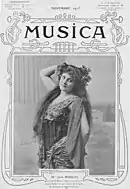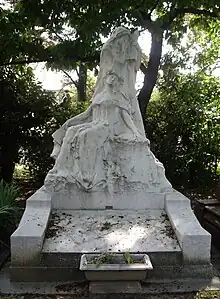Jane Margyl
Jeanne Clémence Floriet (de Margileray) called Jane Margyl (17 July 1874 – 12 August 1907) was a French mezzo-soprano.[2] She began her career as a mime artist at the Folies Bergère starring in several productions. After voice studies, she appeared in operas from 1902 onwards. She first appeared at the Paris Opera in 1905 as Dalila in Samson et Dalila by Saint-Saëns, and took other leading roles there.
Jane Margyl | |
|---|---|
.jpg.webp) | |
| Born | Jeanne Clémence Floriet 17 July 1874 Paris, France |
| Died | 12 August 1907 (aged 33) Deauville, France |
| Occupation | Operatic mezzo-soprano |
| Organizations | |
Life
Born Jeanne Clémence Floriet in Paris,[3] Margyl made her debut as a mime artist at the Folies Bergère[4] on 10 February 1897, creating the title role in Phryné, a ballet-pantomime by Auguste Germain, with music by Louis Ganne.[lower-alpha 1][5][6] Critics praised Margyl's talent as well as her beauty, and she played Phryne more than 200 times.[7][8] In September 1898, she took part there in L'Enlèvement des Sabines, a ballet-pantomime by Adrien Vély and Charles Dutreil, with music by Paul Marcelles, with Odette Valéry, J. Litini and J. Ducastel.[9] On 25 January 1899, she also created the role of Princess Illys in La Princesse au sabbat, a ballet-pantomime by Jean Lorrain, with music by Louis Ganne, alongside Jane Thylda and Odette Valéry.[10][11] In Poussières de Paris, Lorrain described Margyl trying on her princess costume at the couturier Landolff.[12]
She then undertook voice studies with Jules Chevallier[13] and followed the advice of Alexandre Luigini. She made her debut at the Opéra-Comique on 15 November 1902 as Lola in Mascagni's Cavalleria rusticana,[3] opposite Emma Calvé as Santuzza.[14] In December 1902, she appeared in the small role of Princess Olympe in the world premiere of Reynaldo Hahn's La Carmélite. She resumed her voice studies, and in December 1903, Alexandre Luigini called her to replace Lina Pacary in the title role of Massenet's Hérodiade at the Théâtre de la Gaîté.[14]

Engaged at the Paris Opera on 22 December 1904, she first performed there on 22 September 1905 as Dalila in Samson et Dalila by Saint-Saëns and achieved great success.[15][16] She then appeared there on 16 February 1906 as Amneris in Verdi's Aida.[17] On 17 December 1906, she appeared as Fricka in Wagner's Die Walküre.[18]
In the meantime, on 24 April 1906, she took part in creating Le Clown, a musical novel by Victor Capoul, with music by Isaac de Camondo, alongside Geraldine Farrar, Marguerite Mérentié, Rousselière, Renaud and Delmas.[14][19]

She died in Deauville from appendicitis at the age of 33,[20] while she was preparing for the roles of Fidès in Meyerbeer's Le Prophète, Ann Boleyn in Henry VIII and Ortrud in Wagner's Lohengrin.[14] She was buried in Paris at the cimetière des Batignolles (1st division), where a statue by François-Léon Sicard memorializes her, seated and dying, with Euterpe, the classical muse of music, hiding her lyre and her face.[21]
Family
Jane Margyl was the sister of:
- Marthe Floriet (1873–1965), a one-time eccentric comedian known as Miss Floresky.[2]
- Georgette Floriet (1881–1912), wife of Edouard Guillaumet, a publicist and son of the painter Gustave Guillaumet; known in the theatre as Georgette Sandri.[2][22]
- Blanche Floriet, who became duchess Melzi d'Eril di Lodi (1879–1961),[2] mother of the photographer Georgette Chadourne (1899–1983).
- George Floriet.
Notes
- Phryne had been performed in Royan in the summer of 1896 by Cléo de Mérode.
References
- "Jane Margyl". Revue illustrée (in French). 20 October 1906. Retrieved 30 April 2021 – via Gallica.
- "Insouciance / France" (PDF). biennaledisenigallia.it. 2021. p. 12. Retrieved 14 June 2021.
- "Cantatrices de l'Opera-comique". artlyriquefr.fr (in French). 2021. Retrieved 15 June 2021.
- Gutsche-Miller, Sarah (2015). Pantomime and Other Nondanced Scenes. pp. 98–99. ISBN 978-1-58-046442-0.
{{cite book}}:|work=ignored (help) - Stoullig, Edmond (14 February 1897). "La Semaine théatrale: Folies Bergère". Le Monde artiste (in French). pp. 101–103. Retrieved 30 April 2021 – via Gallica.
- Schneider, Louis (15 December 1896). "Échos de théatres". Revue illustrée (in French). pp. 220–221. Retrieved 30 April 2021 – via Gallica.
- Stoullig, Edmond (29 January 1899). "La Semaine Theatrale". Le Monde artiste (in French). p. 70. Retrieved 30 April 2021 – via Gallica.
- "Le Theatre Parisien". Revue d'art dramatique (in French). November 1896. p. 361. Retrieved 30 April 2021 – via Gallica.
- "Folies Bergere". La Revue artistique, littéraire et industrielle (in French). 1 November 1898. Retrieved 30 April 2021 – via Gallica.
- "Propos de Coulisses". Gil Blas (in French). 28 January 1899. Retrieved 30 April 2021 – via Gallica.
- "Chronique Musicale". Le Monde illustré (in French). 5 February 1899. Retrieved 30 April 2021 – via Gallica.
- Lorrain, Jean (2006). Poussières de Paris (in French). Paris: Klincksieck. ISBN 978-2-252-03471-2. OCLC 70120621.
- "Opera". Gil Blas. 1 October 1902. Retrieved 30 April 2021 – via Gallica.
- "Jane Margyl". Le Monde artiste (in French). 18 November 1906. Retrieved 30 April 2021 – via Gallica.
- "Courrier de la semaine". Le Monde artiste (in French). 24 September 1905. p. 621. Retrieved 30 April 2021 – via Gallica.
- Noël, Édouard; Stoullig, Edmond (1905). "22 Septembre". Les Annales du théâtre et de la musique (in French). Retrieved 30 April 2021 – via Gallica.
- "Jane Margyl". Revue illustrée. 20 October 1906. Retrieved 30 April 2021 – via Gallica.
- "Necrologie". La Chronique des arts et de la curiosité (in French). 24 August 1907. Retrieved 30 April 2021 – via Gallica.
- "Paris et Departments". Le Ménestrel (in French). 18 March 1906. Retrieved 30 April 2021 – via Gallica.
- "Necrologie". Revue illustrée (in French). 20 August 1907. Retrieved 30 April 2021 – via Gallica.
- Des Gachons, Jacques (January 1910). "Francois Sicard: L'auteur du Saint Michel du Sacré-Coeur". Le Mois littéraire et pittoresque (in French). pp. 149–54. Retrieved 30 April 2021 – via Gallica.
- "Echos & Nouvelles". Gil Blas (in French). 2 March 1898. Retrieved 30 April 2021 – via Gallica..